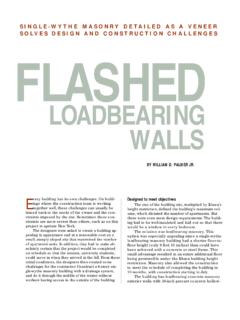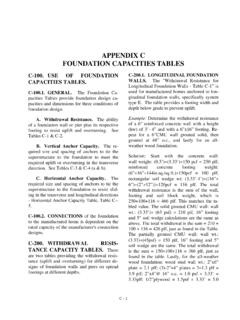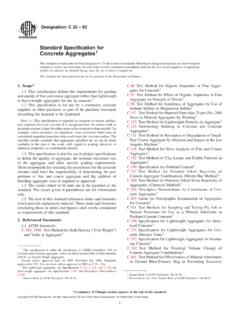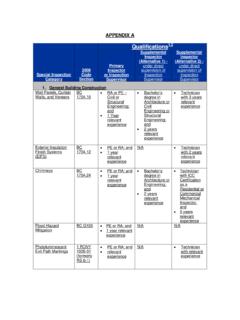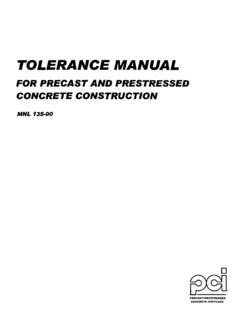Transcription of DENSITY-RELATED PROPERTIES OF CONCRETE MASONRY
1 Extensive testing has established a relationship between thefire resistance and the equivalent solid thickness for concretemasonry walls as shown in Figure 1. Equivalent thickness isessentially the solid thickness that would be obtained if thesame amount of MASONRY contained in a hollow unit wererecast 100% solid without core holes. The equivalent thick-ness of a hollow unit is equal to the percentage solid times theINTRODUCTIONC oncrete MASONRY is a versatile, durable material for theconstruction of building walls that provide load-bearingstrength, fire resistance, a high degree of resistance to soundpenetration and other desirable features. The density of theconcrete mix design used to create a CONCRETE MASONRY unit(CMU or commonly called block) can vary greatly. ThisViewpoint addresses the effects that density has on the phys-ical, aesthetic, engineering and economic characteristics ofconcrete MASONRY North America, a wide variety and blends ofaggregate materials are used to manufacture CONCRETE mason-ry units.
2 CONCRETE block density can range from less than 85pcf to more than 140 pcf. Table 1 shows a range of concretedensities and approximate resulting weights for typical con- crete MASONRY units. ASTM C 90 (Ref. 1) CONCRETE masonryunits must be made with aggregates that meet either ASTM C33 specification for CONCRETE aggregates or ASTM C 331 specification for lightweight aggregates for CONCRETE MASONRY .PHYSICAL PROPERTIESFire ResistanceThe fire resistance of CONCRETE MASONRY walls depends on thegeometry of the CONCRETE MASONRY units, and the density ofthe CONCRETE block. The unit geometry affects the effective or equivalent unit thickness. For a given unit configuration,the fire resistance of a CONCRETE MASONRY wall increases as theconcrete density decreases. (See NCMATEK 7-1A Ref. 4). DENSITY-RELATED PROPERTIES OF CONCRETE MASONRYC oncrete MASONRY offers a variety of color andtexture to the designerTable 1 - Approximate weight (lbs) of oven dry CONCRETE MASONRY units as a function of CONCRETE densityFigure 1 - Fire Resistance Rating Period ofConcrete MASONRY Assemblies (Ref.)
3 4)NominalThicknessSpecifiedThickness% Dry Density of Block ConcreteAddressing concerns of building, fire, and government officials, designers, developers,builders & mason contractorsVolume 1 Number 1 (2007)53% solid unitEquivalent ThicknessEquivalent thickness = x 7 5/8 = 7 5/8 Aggregate Type in theConcrete MASONRY UnitMinimum required equivalent thickness for fire resistance rating, in. (mm)14 hours3 hours2 hours1 hrsCalcareous or siliceous (157) (135) (107) (91) (71) (61) (51)Limestone, cinder or (150) (127) (102) (86) (69) (58) (48)Expanded clay, shale or (130) (112) (91) (84) (66) (56) (46)Expanded slag or (119) (102) (81) (69) (53) (48) (38)1. Fire resistance rating between the hourly fire resistance rating periods listed may bedetermined by linear interpolation based on the equivalent thickness value of the concretemasonry Minimum required equivalent thickness corresponding to the hourly fire resistance rat-ing for units made with a combination of aggregates shall be determined by interpolationbased on the percent by volume of each aggregate used in the thickness of the unit.
4 The percentage solid is deter-mined in accordance with ASTM C 140 (Ref 9). Table 2shows the relationship between fire resistance and equivalentthickness for CONCRETE MASONRY units of varying Resistance (R-Values)R-Values of CONCRETE MASONRY are correlated to CONCRETE den-sity, since thermal conductivity of CONCRETE increases withincreasing density. Table 3 shows the R-Values for a typical8" CMU of various densities with and without insulatedcores. The R value of 12 insulated and reinforced cmu forvarious densities is listed in Fig MassThe effect of thermal mass (also known as thermal inertia) onwalls is well documented. High thermal inertia walls, such asconcrete MASONRY , have the ability to delay and reduce theimpact of outdoor temperature changes on conditioned indoorenvironments, improving energy efficiency. The InternationalEnergy Conservation Code (1994) recognizes most masonrywalls that weigh more than 25 lb per square foot as masswalls.
5 For example, this wall weight is attained with a 90 pcf8 un-reinforced Bearing PropertiesAll CONCRETE MASONRY units, regardless of density, must con-form to ASTMC 90. ASTM C-90 Units must have a mini-mum compressive unit strength of 1900 psi ( ). Ifrequired, compressive strengths considerably higher thanASTM C 90 minimum are readily achieved with low andhigh density and Seismic LoadingLower density units reduce the dead load on supportingbeams, columns and foundations of a structure. This is espe-cially important in mid-rise or high-rise structures. Lowerdensity units also reduce the inertia of a MASONRY wall, whichimproves the building s seismic performance and makesmasonry a more structurally efficient material. >125 Equivalent Thickness (based on trend lines)Conc. Density (pcf)Fire Endurance (hours)<95 Table 2 - Approximate Equivalent Thickness in Inchesby Density (Ref 7)Table 3 - R Value of 8 CMU (Ref.)
6 6)Density(PCF)CoresEmptyCores Insulatedwith PerliteCores Insulatedwith Production Curve05010015020025010 30 50 70 90 ProductionWeightofUnitFigure 2 - CMU Weight vs. Daily Production (ref. 2)Figure 3 - Area of 12 CMU laid by 7 man crew in 5 days vs. Block WeightWall Area Constructed (7 bricklayers - 5 days)05001000150020002500300035004000450 05000550012" CMU (50lb Units)12" CMU (41lb Units)12" CMU (35 lb Units)UnitWallArea( )Weight of UnitDaily Production RateWeight of 1 Cost$ $ $ 4 - Initial Costs by Unit Weight of 12 CMU (ref. 3) Economic CharacteristicsIn estimating MASONRY construction, a common methodemployed by mason contractors is the production ratemethod. The production rate of a given unit is expressed inthe total units a mason can lay in one work day (8 hours).Figure 2 shows the relationship of CMU weight to daily pro-duction of CONCRETE MASONRY units.
7 The figure shows that pro-ductivity increases as the weight of the CMU goes 3 shows the amount of wall area that a typical crew of7 people can build in 5 days using 12 CMU of varying 5 - Life Cycle Energy Cost Analysis Over 30 Year Period(ref. 5)Based on steady state analysis - 5/01/2006 Wall Construction:Location:Single wythe 12" CMU reinforced 48" verticallyChicago, Illinoiswith foamed in place core insulationWinter 2005-06R Value Data135 lb / ft3125 lb / ft3115 lb / ft3105 lb / ft390 lb / ft3R value(1) : U (hr ft2 oF) / BTU. U value in BTU / (hr ft2 oF)135 lb / ft3125 lb / ft3115 lb / ft3105 lb / ft390 lb / ft3 Heating Cost CalculationsNatural Gas Cost(2)per mcf$ $ $ $ $ : $ Cost per Btu Degree Days for This Location(3)64596459645964596459 Calculate: Energy Cost: $ / sq ft / yr$ $ $ $ $ : Energy Cost: $ / block / yr$ $ $ $ $ Worth of Heating Savingsn (years)3030303030i (nominal rate - energy and money)(4) $ $ $ $ $ Cost CalculationsElectricity Cost(2)per kwh$ $ $ $ $ Degree Hours for This Location(3)66066606660666066606 Calculate: Energy Cost: $ / sq ft / yr$ $ $ $ $ : Energy Cost: $ / block / yr$ $ $ $ $ Worth of Cooling Savingsn (years)3030303030i (nominal rate - energy and money)(4) $ $ $ $ $ $ $ $ $ $ : Present Worth of Total Wall Heating and CoolingCost, $ / blockCMU DensityCMU DensityCalculate: Present Worth of Wall Heating Costs, $ / blockCalculate.
8 Present Worth of Wall Cooling Costs, $ / blockThe following analysis caclulates annual heating and cooling costs for the CONCRETE MASONRY wall. All units are conventional 12" x 8" x 16" Wall Costs and DensityThe initial cost of a CONCRETE MASONRY wall is a function ofmaterial cost, labor cost and contractor's overhead and largest single factor is the cost of labor required to con-struct the wall. Many experienced estimators and project managers recognizethe relationship between the density of the CONCRETE masonryunits and the labor cost. This relationship is reflected in thecost data obtained through market research in Illinois ( ).(1) R-values for Single Wythe CONCRETE MASONRY Walls, TEK 6-2A, National CONCRETE MASONRY Association, 1996. The R value is interpolated for 90 pcf. (2)Natural Gas and Electricity Costs: Illinois MASONRY Institute. Current for Winter 2005-06.(3) Appendix A, Climactic Data for the US and Canada, ASHRAE , 1993.
9 (4) The 2% nominal discount rate was chosen as appropriate for this analysis because it represents the typical long term two percent difference between short termUS T-bill rates and the CPI inflation rate. See Office of Management and Budget Circular A-94 Guidelines and Discount Rates for Benefit-Cost Analysis ofFederal Programs. Calculations are based on Expanded Shale, Clay & Slate Institute (ESCSI) Information Sheet No. 3530. 1 ASTM C 90-06b, Standard Specification for Load Bearing CONCRETE MASONRY Units, ASTM International, Inc. 20062 Kolkoski Rynold V., MASONRY Estimating. The Aberdeen Group, 19953 MASONRY Cost Guide, MASONRY Advisory Council, 20074 NCMA TEK 7-1A. Fire Resistance Rating of CONCRETE MASONRY Assemblies, National CONCRETE MASONRY Information Sheet 3530, Life Cycle Energy Cost Analysis, Expanded Shale, Clay and Slate Institute, 20006 NCMA TEK 6-2A, R-Values of Single Wythe CONCRETE MASONRY Walls, National CONCRETE MASONRY of data from NCMA Library FPD00123, Fire Resistance of CONCRETE MASONRY Walls, NCMA technical Committee Task Group on CONCRETE MASONRY Fire Mass, The International energy Conservation Code (IEEC), International Code Council, Country Club Hills, Ill, 20049 ASTM C 140, Standard Method of Sampling and Testing CONCRETE MASONRY Units, ASTM International.
10 Although care has been taken to ensure the enclosed information is accurate and complete as possible, the MASONRY AdvisoryCouncil does not assume any responsibility for errors or omissions resulting from the use of this CONSIDERATIONSOne of the most significant architectural benefits of designingwith CONCRETE MASONRY is its versatility in the finished appear-ance of a CONCRETE MASONRY wall can be varied with the unitsize and shape, color of units and mortar, bond pattern, andsurface finish of the units. The term architectural concretemasonry units typically is used to describe units displayingany one of several surface finishes that affects the texture ofthe unit, allowing the structural wall and finished surface to beinstalled in a single CONCRETE MASONRY units are used for interior andexterior walls, partitions, terrace walls, and other units are available with the same treatment or pattern onboth faces, to serve as both exterior and interior finish wallmaterial, increasing both the economic and aesthetic advan-tages.


